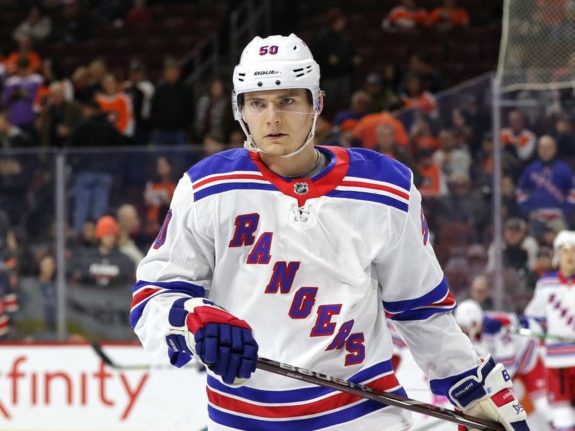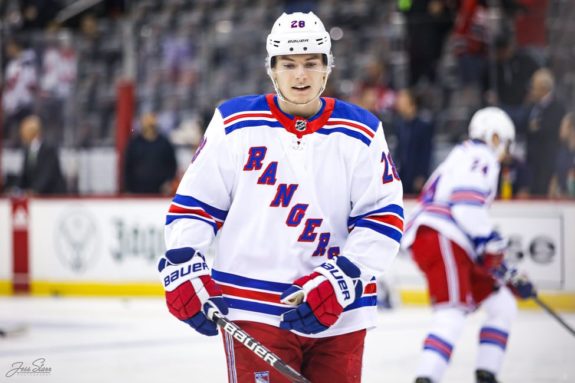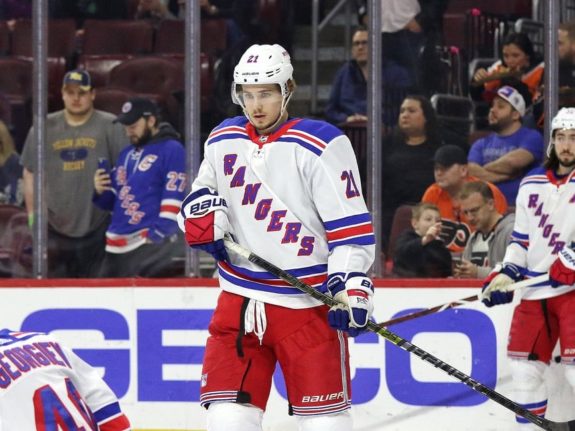Since the beginning of the season, there’s been a looming decision on the horizon. With injuries building up and certain players stepping up, Lias Andersson remained in the stagnant position as fourth-line center, much to the dismay of the New York Rangers fanbase.
As the season progressed and his average time on ice continued to stay at a sub-10-minute mark, Andersson’s role in the roster quickly began to diminish. Thus, the Rangers brass voted to send the former seventh overall selection back to the Hartford Wolf Pack of the American Hockey League, as he continues to develop into what the Rangers hope will be a roster mainstay.

What is particularly clear is that the Rangers never really had a plan for Andersson, despite head coach David Quinn saying otherwise. If there was a real plan for him, the Rangers staff would have sent him to the AHL when he first began to struggle, instead of letting him skate for less than 10 minutes a night and inevitably fail. For the foreseeable future, he will get plenty of work in the minors and see a considerably larger amount of ice time with debatably better and more equipped linemates.
Where Did it Go Wrong?
Before diving into the semantics of Andersson’s recent play and the reasoning behind dropping him into the minors, it’s imperative to know that the Rangers in no way, shape, or form have lost faith in him. (from ‘Everything is on the table for Rangers when it comes to Lias Andersson,’ New York Post, 11/18/2019) The coaching staff, front office, and everyone between still think Andersson can be a viable roster player in the near future. Unfortunately, his development is just taking longer than expected.
This will be the third straight season that Andersson has been dropped to the minors. Through 66 total NHL games, the 21-year-old has logged nine points while averaging just 10:33 of time-on-ice. What’s particularly worrying is that his ice time has gradually diminished over his three-year span at the NHL level.

In 2017-18, he averages nearly 12 minutes of TOI in a seven-game stint, then 10:43 during his much longer 42-game tryout in 2018-19. However, this season he’s logged just 9:33 TOI over 17 games, nearly six minutes less than the 15:26 ATOI he logged in his four preseason games.
His most recent demotion comes after a loss to the Florida Panthers where he logged just 3:55 of ice time. Only the recently waived Micheal Haley had less ice time. (from ‘Rangers waive Micheal Haley after brutal road trip,’ New York Post, 11/17/2019)
Even when Andersson was given ice time, it was mostly on the fourth line with defenseman turned forward, Brendan Smith, and journeyman Greg McKegg. That unfortunately put Andersson in a less-than-ideal situation to succeed, yet his both his linemates have had a decent amount of success this season.

There’s also the question of Brett Howden and whether he should be centering the third line of Brendan Lemieux and Kaapo Kakko. The underlying advanced stats prove that neither Andersson or Howden are truly ready for large NHL roles. Where Howden has truly stepped up his game is on the penalty kill. Besides Jesper Fast (and technically Smith but he plays defense on the PK), Howden has the second most PK ice time among forwards. Andersson had all but lost his spot on the PK once Mika Zibanejad was sidelined with his current neck/head injury.
As far as five-on-five play goes, Howden has been the clear cut favorite between the two 21-year-olds. While both have struggled thus far, Andersson has seen his ice time gradually decrease while his counterpart has found himself in an increased role, averaging 15:41 minutes a night. The combination of Quinn’s increased trust in Howden and Andersson’s lack of ice time due to his inconsistent play spelled out a miserable 17-game for the young Swede and his inevitable demotion.
Development in Hartford
By going to the AHL, Andersson should find himself in a position of far more responsibility and overall ice time. The young center has 34 points in 61 career games with the Wolf Pack. In both seasons, he’s averaged .56 points-per-game in his two years of AHL experience. Nearly all of his points came at even strength as he finds very little time on the power play.
Andersson has logged just a single power-play goal in his AHL career. However, the Wolf Pack own a bottom-five percentage on the man advantage. Perhaps the coaching staff will see some upside to putting Andersson somewhere on all aspects of special teams.
Despite losing both Filip Chytil and Ryan Lindgren to the NHL, the Wolf Pack have had a fantastic season, leading the league with an 11-1-5 record thus far. It goes without saying but playing on a good team can be huge for a player’s morale. The Wolf Pack were a non-playoff team in both of the seasons Andersson was with the team.

Before joining the Rangers, Chytil was a primary reason for the Wolf Pack success. He logged nine points in the nine games he was in the minors. Since being called back up, six goals and one assist in nine games with the Rangers. Being sent down to the minors hasn’t worked for every Rangers prospect, but it certainly did for Chytil. One can only hope Andersson will follow in his footsteps as he takes the first line spot with Vinni Lettieri and Danny O’Regan where Chytil once was.
Trade Deadline Implications
His stay in the minors will likely remain that way only until the trade deadline. The Rangers should be dangling Ryan Strome, Chris Kreider, Alexandar Georgiev or Fast come the Feb. 24 deadline. All four are on expiring contracts and don’t seem to be in the Rangers’ long-term plans. The deadline should, at the very least, open up a roster spot. However, that future spot could be on the wing rather than at his natural center.
However, it’s possible that Andersson’s name may be floated as well in trade talks. There’s been various rumors of Jesse Puljujarvi being involved in a young player swap. Letting him play in Hartford and get himself far more exposure could eventually help his trade value should the Rangers consider that option.
The writing was on the wall for Andersson. His limited ice time and lack of consistency were a recipe for another demotion to the minors. He should have been put in a better situation to succeed, whether that means third line minutes or an increased role on the wing, but he failed to earn such a role. The next step will be crucial for his future development, whether that’s a trade or extended time in the minors.